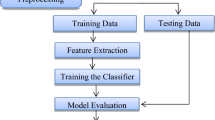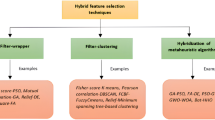Abstract
Recently, social media are the most popular way of consuming news for people due to their fast, low cost, and easy accessibility. Unfortunately, in order to provide financial, political, or personal interests on social media, a large amount of fake news is intentionally produced that contains false information. Although fake news detection is a very important problem to avoid negative effects, efficient studies on this issue are limited. More efficient models are required in order to obtain better solutions with respect to different metrics for fake news detection. In this paper, a novel model was proposed that uses optimization methods for fake news detection. In addition, an improved Salp Swarm Optimization (SSO) based on a nonlinear decreasing coefficient and oscillating inertia weight was proposed to find the best optimum solution for fake news detection for the first time. The standard SSO, Grey Wolf Optimization (GWO) which is one of the most recent swarm intelligence algorithms, and two new adaptive SSO methods were modeled to detect fake news for the first time in this study. These methods were tested over four different real-world fake news data sets to verify the performance of the algorithms proposed in this paper. Furthermore, Friedman test was conducted to distinguish the differences among these methods. The obtained results prove that the proposed new model is significantly superior to standard SSA and GWO on the real-world fake news data sets.














Similar content being viewed by others
References
Ahmed H, Traore I, Saad S (2017) Detection of online fake news using N-gram analysis and machine learning techniques. International conference on intelligent, secure, and dependable Systems in Distributed and Cloud Environments, Canada
Allahyari M, Pouriyeh S, Assefi M, Safaei S, Trippe ED, Gutierrez JB, Kochut K (2017) A brief survey of text mining: classification, clustering and extraction techniques. arXiv preprint arXiv:1707.02919
Anderson PA, Bone Q (1980) Communication between individuals in salp chains. II. Physiology, Proceedings of the Royal Society of London. Series B. Biological Sciences 210(1181):559–574. https://doi.org/10.1098/rspb.1980.0153
Bhatt G, Sharma A, Sharma S, Nagpal A, Raman B, Mittal A (2017) On the benefit of combining neural, statistical and external features for fake news identification. arXiv preprint arXiv:1712.03935
Engel P (2014) Here are the most-and least-trusted news outlets in America. Business Insider
Fang Y, Gao J, Huang C, Peng H, Wu R (2019) Self multi-head attention-based convolutional neural networks for fake news detection. PLoS One 14(9):e0222713. https://doi.org/10.1371/journal.pone.0222713
Girgis S, Amer E, Gadallah M (2018) Deep learning algorithms for detecting fake news in online text. 13th international conference on computer engineering and systems (ICCES), Cairo, Egypt
Horne BD, Adali S (2017) This just in: fake news packs a lot in title, uses simpler, repetitive content in text body, more similar to satire than real news. Eleventh International AAAI Conference on Web and Social Media, Canada
Ishitaki T, Oda T, Barolli L (2016) A neural network based user identification for Tor networks: data analysis using Friedman test. In 2016 30th international conference on advanced information networking and applications workshops (WAINA). https://doi.org/10.1109/WAINA.2016.143
Kentzoglanakis K, Poole M (2009) Particle swarm optimization with an oscillating inertia weight. 11th Annual conference on Genetic and evolutionary computation (GECCO), Canada
Kim J, Tabibian B, Oh A, Schölkopf B, Gomez-Rodriguez M (2018) Leveraging the crowd to detect and reduce the spread of fake news and misinformation. Eleventh ACM International Conference on Web Search and Data Mining, California
Li Z, Wang M, Liu J, Xu C, Lu H (2011) News contextualization with geographic and visual information. In Proceedings of the 19th ACM international conference on Multimedia, pp 133–142
Li Z, Tang J, Wang X, Liu J, Lu H (2016) Multimedia news summarization in search. ACM Trans Intell Syst Technol 7(3):1–20
Liu Y, Wu YFB (2018) Early detection of fake news on social media through propagation path classification with recurrent and convolutional networks. 32nd AAAI conference on artificial intelligence, Louisiana, USA
Madin LP (1990) Aspects of jet propulsion in salps. Can J Zool 68(4):765–777. https://doi.org/10.1139/z90-111
Mirjalili S, Mirjalili SM, Lewis A (2014) Grey wolf optimizer. Adv Eng Softw 69:46–61. https://doi.org/10.1016/j.advengsoft.2013.12.007
Mirjalili S, Gandomi AH, Mirjalili SZ, Saremi S, Faris H, Mirjalili SM (2017) Salp swarm algorithm: a bio-inspired optimizer for engineering design problems. Adv Eng Softw 114:163–191. https://doi.org/10.1016/j.advengsoft.2017.07.002
Monti F, Frasca F, Eynard D, Mannion D, Bronstein MM (2019) Fake news detection on social media using geometric deep learning. arXiv preprint arXiv:1902.06673
Ozbay FA, Alatas B (2019) A novel approach for detection of fake news on social media using metaheuristic optimization algorithms. Elektron Elektrotech 25(4):62–67
Ozbay FA, Alatas B (2020) Fake news detection within online social media using supervised artificial intelligence algorithms. Physica A Stat Mech Appl 540:540. https://doi.org/10.1016/j.physa.2019.123174
Pérez-Rosas V, Kleinberg B, Lefevre A, Mihalcea R (2017) Automatic detection of fake news. arXiv preprint arXiv:1708.07104
Pierri F, Ceri S (2019) False news on social media: a data-driven survey. arXiv preprint arXiv:1902.07539
Potthast M, Kiesel J, Reinartz K, Bevendorff J, Stein B (2017) A stylometric inquiry into hyperpartisan and fake news. arXiv preprint arXiv:1702.05638. https://doi.org/10.18653/v1/P18-1022
Qian F, Gong C, Sharma K, Liu Y (2018) Neural user response generator: fake news detection with collective user intelligence. International joint conference on artificial intelligence, Stockholm, Sweden
Rubin V, Conroy N, Chen Y, Cornwell S (2016) Fake news or truth? Using satirical cues to detect potentially misleading news. Second Workshop on Computational Approaches to Deception Detection, California
Ruchansky N, Seo S, Liu Y (2017) Csi: A hybrid deep model for fake news detection. 2017 ACM on conference on information and knowledge management, Singapore
Shu K, Sliva A, Wang S, Tang J, Liu H (2017) Fake news detection on social media: a data mining perspective. SIGKDD Explor 19(1):22–36.
Singhania S, Fernandez N, Rao S (2017) 3han: a deep neural network for fake news detection. International Conference on Neural Information Processing, China
Social media. https://en.wikipedia.org/wiki/Social_media, Accessed 27 Jan 2021
Tacchini E, Ballarin G, Della Vedova ML, Moret S, de Alfaro L (2017) Some like it hoax: automated fake news detection in social networks. arXiv preprint arXiv:1704.07506
Tang Q, Gu B, Whinston AB (2012) Content contribution for revenue sharing and reputation in social media: a dynamic structural model. J Manage Inform Syst 29(2):41–76. https://doi.org/10.2753/MIS0742-1222290203
Wang WY (2017) Liar, liar pants on fire: a new benchmark dataset for fake news detection. Proceedings of the 55th annual meeting of the Association for Computational Linguistics (Volume 2: short papers)
Wang Y, Ma F, Jin Z, Yuan Y, Xun G, Jha K, Shu L, Gao J (2018) Eann: event adversarial neural networks for multi-modal fake news detection. 24th ACM SIGKDD international conference on Knowledge Discovery & Data Mining, London, United Kingdom
Yang C, Gao W, Liu N, Song C (2015) Low-discrepancy sequence initialized particle swarm optimization algorithm with high-order nonlinear time-varying inertia weight. Appl Soft Comput 29:386–394. https://doi.org/10.1016/j.asoc.2015.01.004
Yang S, Shu K, Wang S, Gu R, Wu F, Liu H (2019) Unsupervised fake news detection on social media: a generative approach. 33rd AAAI conference on artificial intelligence, Hawai, USA
Zhang L, Wang S, Liu B (2018) Deep learning for sentiment analysis: a survey. Wiley Interdisciplinary Reviews: Data Mining and Knowledge Discovery 8(4). https://doi.org/10.1002/widm.1253
Zimdars M (2016) False, misleading, clickbaity, and satirical news sources. Google Docs
Author information
Authors and Affiliations
Corresponding author
Additional information
Publisher’s note
Springer Nature remains neutral with regard to jurisdictional claims in published maps and institutional affiliations.
Rights and permissions
About this article
Cite this article
Ozbay, F.A., Alatas, B. Adaptive Salp swarm optimization algorithms with inertia weights for novel fake news detection model in online social media. Multimed Tools Appl 80, 34333–34357 (2021). https://doi.org/10.1007/s11042-021-11006-8
Received:
Revised:
Accepted:
Published:
Issue Date:
DOI: https://doi.org/10.1007/s11042-021-11006-8




